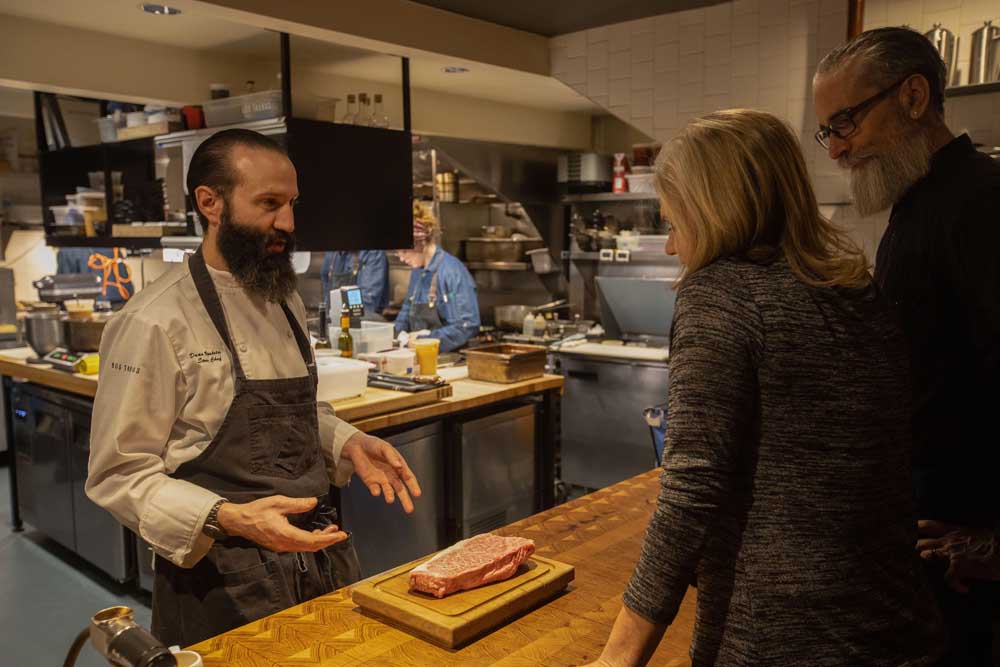Open kitchens create a different dining experience
Published 2:30 am Thursday, March 5, 2020

- Sous Chef Dean Bosteter shows a customer a well-marbled Wagyu Miyazaki tenderloin.
There are many reasons why restaurateurs and diners appreciate an open kitchen.
Cooking in front of the guests provides transparency. Diners see how the food is handled, that it is fresh and not microwaved and that the kitchen is clean. When the kitchen is open to the dining area, it creates a physically integrated environment and a sense of community.
In recent years, many of us have gotten hooked on viewing TV cooking shows. Watching the artful cooking techniques and combinations of ingredients has become entertainment — part of the experience of dining out.
The open-kitchen concept grew out of the “chef’s table” experience, where diners sit at a special VIP table in the kitchen for a privileged view of all that is happening in the kitchen.
At some time during the meal, the chef stops by and discusses the food, wine and more.
A few Central Oregon restaurants offer open-kitchen experiences. Drake, Washington Dining & Cocktails and Miyagi Ramen have counters and stools so you can sit near the kitchen. Bos Taurus and Boxwood Kitchen don’t have counter seating, but the kitchens are in plain sight and accessible to diners who want to talk to the staff.
I do not include sushi bars or Izakaya Ronin in this story. While 900 Wall has an open kitchen, its counter is used for service pickup only.
My first stop, Drake, felt like a true open kitchen experience. I watched the chef saute mushrooms and red onions that he then piled high atop my elk Salisbury steak entree. Executive chef John Gurnee came out from the kitchen to chat with customers who sat at the counter. Gurnee said customers often ask what plate is being prepared, or inquire about the name of a mouth-watering dish that is awaiting pickup. Many diners will inquire how a dish is being prepared, asking for tips of the trade.
Ted Swigert, owner of Drake and Washington, enjoys that type of interaction between the kitchen and customers. That’s why he said he opted for an open kitchen at both of his restaurants. Coming from Washington, D.C., Swigert said he wanted an open kitchen as it “adds to the more urban feel to the restaurant, more energy like you’d find in a bigger city. It has a neighborhood feel and vibe and the action in the kitchen adds to that energy, noise and action … and you’re not putting a chef behind a wall.”
Swigert continued, “Both restaurants prepare food to order. There are no microwaves.” He acknowledged that Drake offers a more intimate experience than Washington, as the latter restaurant’s kitchen extends back, away from the diners. “At Drake, it’s pretty neat to watch your food develop,” he said. He likened it to “being at someone’s house where you feel like a part of what’s going on.”
At Boxwood Supper Club, diners can sit at the bar and see what’s being prepared in the open kitchen. Although there are no stools in front of the kitchen counter, it is an open area where a diner can walk up and watch or ask questions. Chef-owner Eric Rud explained that his previous restaurant in San Francisco had an open kitchen with counter seating. He particularly liked the social interaction with customers, but it became too much, he said: “I loved it, but it totally distracted me from doing my job … (we’d be) having a laugh and the next thing you know, something is burning.”
Rud talked about another advantage of an open kitchen — that it “keeps you honest. It forces people to work more clean and be more proud of the product they put out.” He added, “It’s real. When you look back there, whatever’s going on is real.”
Dean Bosteter, sous chef at Bos Taurus, is proud of the restaurant’s beautiful open kitchen. He said the chefs are “putting on a show for the people who come in here.”
Bosteter talked about the importance of aesthetics and keeping things organized. Towels are folded. Knives are lined up on towels on the cutting boards. Little blue labels for jars and bins are carefully cut into squares with neatly printed wording. While these details may not be obvious, it’s part of the overall aesthetic of the kitchen that, taken as a whole, is an extension of the rest of the restaurant.
Bos Taurus’ open kitchen is not only a visual extension of the dining room, it adds to the overall sound level of the restaurant. With no walls separating them from the clientele, the kitchen staff must be aware that sound will carry into the restaurant. Metal cabinet doors are closed quietly and gingerly. Everyone in the kitchen is careful about what they say and how loud they are talking.
There are no seats in front of the kitchen, but those dining downstairs have a direct view. While I was there, a woman wanted to see a cut of meat, so a server brought her to the kitchen service area. Bosteter displayed a piece of well-marbled Japanese Miyazaki tenderloin and explained the difference between that cut of beef and others.
Many of those who work in open kitchens enjoy the interaction with diners. Still, if you are dining at a restaurant with such a kitchen, please keep in mind that the staff is busy preparing food. Ask if it’s a good time before launching into a conversation. This allows the chef to come to you and give you his or her full attention. Also, be aware if you may be standing in the way of servers who need to retrieve food or drinks.
Enjoy the show at open kitchens, and don’t be shy.






